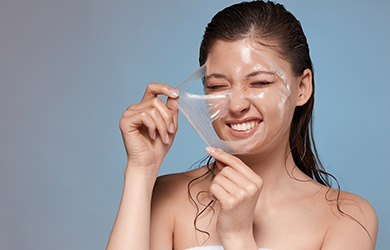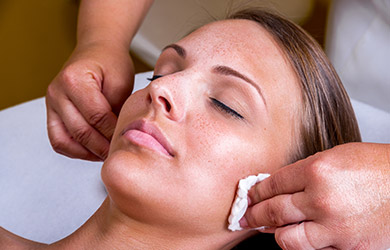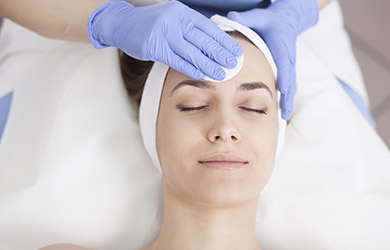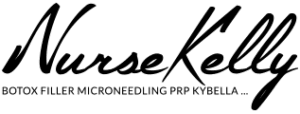
Conveniently located on Seven Mile Beach, Grand Cayman

Step into a world of radiant skin transformation with Nurse Kelly, where the artistry of chemical peels becomes a personalized journey to unveil your skin’s natural brilliance. Nurse Kelly employs specialized skincare treatments, including the invigorating ZO Skin Health Lunchtime Stimulator Peel, the transformative ZO 3 Step Peel, , the illuminating Blue Peel Radiance by Obagi, the unparalleled Blue Peel series by ZO Medical, the rejuvenating VI Peel and The Perfect Derma Peel. These transformative peels work by exfoliating the outer layer of the skin, promoting cell turnover, and stimulating the production of collagen and elastin. Nurse Kelly’s expertise extends to providing a customised approach to skincare excellence.
If you find yourself contemplating a minimally invasive approach to combat the signs of aging, look no further than chemical peels. These transformative skincare treatments offer a subtle yet effective solution to address fine lines, wrinkles, and uneven skin tone. Chemical peels work by exfoliating the outer layer of the skin, promoting cell turnover, and stimulating the production of collagen and elastin. The result is a rejuvenated and radiant complexion with no significant downtime.
To learn more about chemical peels, please don’t hesitate to contact us at 1 (345) 943-6363 to learn more about chemical peels or book an . We are located at West Shore Center (Pink Plaza), 508 West Bay Road, PO Box 32078, Grand Cayman KY1-1208, Cayman Islands, B.W.I.
Discover the power of tailored chemical peels that Nurse Kelly meticulously selects for each client, and embark on a consultation with one of our highly trained and experienced practitioners at Cayman Doctors to unveil the ideal peel for your skin’s unique needs.
Fast Facts
Who’s it for?
Chemical peels are suitable for individuals looking to address signs of aging, improve skin texture, reduce hyperpigmentation, and achieve a refreshed complexion.
Similar products:
Microdermabrasion, Dermaplaning, Enzymatic peels
Celebs who swear by it:
Victoria Beckham, Gwyneth Paltrow, Jennifer Aniston
What are Chemical Peels?
Chemical peels are skincare treatments designed to improve the texture and appearance of the skin. They involve the application of a chemical solution to the skin, which causes controlled exfoliation of the outer layer, leading to smoother, rejuvenated skin underneath.
How Chemical Peels Work

Chemical peels work by utilizing different types of acids or other chemicals to remove the outer layer of the skin. This process stimulates cell turnover, collagen production, and the growth of new, healthier skin. The depth of penetration varies based on the type and strength of the peel, allowing for customization to address specific skincare concerns.
Advantages of Chemical Peels
Chemical peel offers numerous advantages, including:
- Diminish Fine Lines and Wrinkles: Chemical peels effectively reduce the appearance of fine lines and wrinkles, promoting a smoother and more youthful complexion.
- Address Hyperpigmentation: These peels target hyperpigmentation issues, such as sun spots and age spots, resulting in a more even and radiant skin tone.
- Improve Skin Texture: By stimulating cell turnover, chemical peels enhance the texture of the skin, leaving it smoother, softer, and rejuvenated.
- Treat Acne Scars: Chemical peels provide a solution for individuals with acne scars, aiding in the reduction of scarring and promoting a more even skin surface.
- Non-Surgical and Minimally Invasive: Unlike surgical procedures, chemical peels offer a non-surgical, minimally invasive approach to skin rejuvenation, reducing the need for extensive downtime.
- Quick Recovery Times: Clients can enjoy relatively quick recovery times with chemical peels, allowing them to return to their daily activities sooner while still achieving noticeable improvements in their skin’s appearance.
What Brands Do We Use?
Nurse Kelly relies on top-tier brands for chemical peels to ensure optimal results. The selection includes the ZO Skin Health Lunchtime Stimulator Peel, the ZO 3 Step Peel, and the Blue Peel series by ZO Medical. Nurse Kelly also utilises the Blue Peel Radiance by Obagi, the VI Peel, and The Perfect Derma Peel. These trusted brands prioritize quality and effectiveness, catering to various skincare concerns with a commitment to delivering excellent outcomes for our clients.
ZO Skin Health Lunchtime Stimulator Peel
The ZO Skin Health Lunchtime Stimulator Peel is a gentle peel that can be used to improve the appearance of dull, uneven skin. It is a good option for people who are new to chemical peels or who have sensitive skin. The peel is typically performed in a series of three treatments, spaced four weeks apart.
ZO 3-Step Peel
The ZO 3-Step Peel is a stronger peel that is used to address a wider range of skin concerns, including wrinkles, fine lines, acne, and hyperpigmentation. You will need to get your skin ready for this peel by using ZO Skin Health products for a few weeks before the first peel. The peel is typically performed in a series of three treatments, spaced six weeks apart.
Blue Peel (ZO Medical)
The Blue Peel is a controlled-depth peel that is used to address more severe skin concerns, such as deep wrinkles, scars, and sun damage. The peel is typically performed in a single treatment but may be repeated as needed. Your skin will need to be ready for this peel and has the most down time of any of the peels performed at Cayman Doctors.
Blue Peel Radiance by Obagi
The Blue Peel Radiance is a light-depth peel that is used to improve the appearance of dull, uneven skin. It is a good option for people who are looking for a quick and effective way to brighten their complexion. The peel is typically performed in a single treatment.
VI Peel
The VI Peel is formulated with a blend of ingredients that work together to exfoliate the skin, stimulate collagen production, and reduce inflammation. It is typically performed in a single treatment but may be repeated as needed. The procedure takes about 30 minutes and is typically performed in a dermatologist’s office.
The Perfect Peel
The Perfect Peel is a medium-depth chemical peel that is designed to improve the appearance of the skin by removing dead skin cells, stimulating collagen production, and reducing the appearance of wrinkles, fine lines, acne scars, and hyperpigmentation. It is a versatile peel that can be used on all skin types, including sensitive skin. The peel is typically performed in a single treatment but may be repeated as needed.
Risks and Complications of Chemical Peels
While generally safe, chemical peels carry some risks, including redness, irritation, and changes in skin pigmentation. In rare cases, complications such as scarring or infection may occur.
Nurse Kelly is committed to ensuring a safe and effective chemical peel experience for each client. With her expertise, Nurse Kelly customizes treatment plans and meticulously selects the most suitable peels based on individual skin types and concerns, helping to prevent potential risks and complications. Dr. Christoffersen, our Dermatologist at Cayman Doctors, works closely with Nurse Kelly to conduct a thorough health assessment for all potential candidates, further reducing the risk of complications. This comprehensive approach aims not only to enhance the overall safety of the procedure but also to achieve optimal and satisfying results for our clients, ensuring a positive and rejuvenating skincare experience.
What to Expect Before Chemical Peels

Before a chemical peel, clients can expect a consultation with one of our practitioners at Cayman Doctors to assess their skin type, concerns, and suitability for the procedure. Pre-peel preparations may include discontinuing certain skincare products and medications to optimize peel effectiveness and minimize risks.
What to Expect During Chemical Peels
During a chemical peel, Nurse Kelly carefully applies the chosen solution to the skin. Clients may experience a tingling or mild burning sensation, which is normal. The duration of the procedure varies based on the type of peel and individual skin response.
Chemical Peel Recovery Time
Recovery time after a chemical peel varies depending on the depth of the peel and condition of the skin at the time of the peel. Superficial peels may result in a few days of redness and peeling, while deeper peels may require a more extended recovery period.
Conditions Treated by Chemical Peels
Chemical Peels effectively treat a range of conditions, including fine lines, wrinkles, sun damage, acne scars, and hyperpigmentation. Nurse Kelly in collaboration with Dr. Christoffersen tailors the choice of peel to address specific concerns and achieve optimal results for each client’s unique skin profile.
Fine Lines and Wrinkles
Chemical peels effectively treat fine lines and wrinkles by inducing controlled exfoliation of the skin’s outer layer, stimulating the production of new skin cells. The chemical solution applied during the peel works to remove damaged or aged skin, promoting collagen and elastin production. As a result, the skin becomes smoother, firmer, and more youthful, with a visible reduction in the appearance of fine lines and wrinkles.
An advanced facial chemical peel, featuring a physician-strength superficial peel with 3% retinol and other firming components, was developed to address photodamage, acne, and melasma (brown or grayish-brown facial patches). [1] This formulation aimed to exfoliate, enhance the appearance of fine lines and wrinkles, and plump and firm the skin, ultimately promoting a luminous and even complexion. A clinical study, including 24 subjects with various skin concerns and types, assessed the tolerability, safety, and efficacy of the 3% retinol peel administered at 6-week intervals over 2-4 sessions. Results demonstrated that the peel, combined with a supportive homecare regimen, was well-tolerated across diverse skin conditions, with noticeable benefits in fine lines, wrinkles, and overall photodamage, supporting its efficacy as a cosmetic treatment under physician supervision.
In a study involving 32 female subjects with mild-to-moderate facial aging (Fitzpatrick Skin Types I-V), three monthly treatments of a combination peel containing 6% trichloroacetic acid and 12% lactic acid demonstrated significant enhancements in clarity, brightness, redness, pigmentation, fine lines, tactile and visual roughness, and overall appearance scores. [2] Subjective improvements in photoaging parameters ranged from 53% (fine lines) to 91% (clarity/brightness).
A study involving 20 female volunteers aged 40-65 explored the efficacy of combined chemical peels and antioxidants for skin rejuvenation, with a focus on minimizing downtime. [3] Administered over eight treatments every seven days, azelaic acid was applied to the entire face, followed by a 40% vitamin C solution on the right side and 10% vitamin C with microneedling on the left side. The results revealed significantly improved hydration and skin elasticity, with superior outcomes on the microneedling side. Reductions in melanin and erythema (skin redness) index were observed with no significant side effects.
Treatment Options
Chemical peels treat fine lines and wrinkles by inducing controlled exfoliation, promoting the removal of damaged outer skin layers and stimulating the production of new, smoother skin.
Sun Damage
Sun damage, also known as photodamage, refers to the harm caused to the skin by prolonged exposure to the sun’s ultraviolet (UV) rays. Over time, this exposure can lead to various signs of damage, including wrinkles, fine lines, uneven pigmentation, and a loss of skin elasticity. Additionally, sun damage increases the risk of skin cancers.
Chemical peels effectively treat sun damage by promoting the exfoliation of the damaged outer layer of the skin. The peeling process encourages the growth of new, healthier skin cells, reducing the appearance of sun-induced issues such as fine lines, wrinkles, and hyperpigmentation. Through this renewal process, chemical peels contribute to a more even skin tone and texture, helping to reverse the effects of sun damage.
A study compared the efficacy of topical tretinoin (0.25%) and retinol (0.25%) for improving photodamage on human facial skin, both applied after a 30% salicylic acid peel. [4] In a split-face study involving twenty female subjects, the researchers found that both regimens were effective in enhancing photodamage parameters compared to baseline, with improvements in texture, roughness, pores, dryness, erythema, and overall appearance. Tretinoin was slightly more effective than retinol in improving texture, roughness, and overall appearance according to investigator evaluation. Subject self-assessment revealed both tretinoin and retinol significantly improved overall appearance with no significant difference between the two.
A study assessed the mode of action of a commercial professional chemical peel for treating hyperpigmented and photoaged skin, commonly addressed by dermatologists, plastic surgeons, and aestheticians. [5] In in-vitro experiments, the peel exhibited the inhibition of enzymes responsible for collagen and elastin degradation, as well as melanin pigment production. Surprisingly, trichloroacetic acid (TCA), known for its cauterant action, synergistically enhanced the inhibitory effects of lactic acid, potentially due to a conformational change in TCA’s structure. Collagen and elastin up-regulation in 3D human skin equivalents treated with the peel was validated by in-vitro results, and ex-vivo testing on human skin biopsy confirmed significant melanin reduction and photodamage repair.
In one study, the efficacy of a medium-depth chemical peel, specifically a 40% trichloroacetic acid (TCA) peel, was investigated for treating actinic damage in sixteen men, including actinic keratoses (rough, scaly patches on the skin caused by prolonged exposure to ultraviolet rays from the sun). [6] Half of the participants underwent pretreatment with topical tretinoin for six weeks, continuing its use after the peel. The study concluded that the medium-depth chemical peel alone produced moderate improvement in certain manifestations of actinic damage, with tretinoin use before and after the peel not significantly enhancing its efficacy.
Treatment Options
Chemical peels treat sun damage by exfoliating the damaged outer layer of the skin, stimulating the production of new skin cells, and reducing the appearance of sun-induced issues such as fine lines, wrinkles, and hyperpigmentation.
Acne Scars
Chemical peels can effectively treat acne scars by promoting controlled exfoliation of the skin’s outer layer, which encourages the growth of new, healthier skin cells. The peeling process helps to reduce the appearance of acne scars, including shallow depressions and uneven skin texture. Different types and strengths of chemical peels can be customized to address specific acne scars, providing a non-invasive solution for skin rejuvenation.
A study assessed the effectiveness of medium-depth chemical peels in treating acne scars, involving 15 patients (14 women and 1 man) who underwent peeling sessions using Jessner’s solution followed by the application of 35% trichloroacetic acid (TCA). [7] The patients, with a mean age of 28 years, presented two forms of acne scars: the atrophic saucer or crater-like form and the pitted (ice-pick) form. Improvement was observed in all patients except one, with significant, moderate, mild, and minimal improvements reported in varying percentages. Despite transient postinflammatory hyperpigmentation observed in 73.4% of patients, the study concluded that medium-depth chemical peels were a safe and effective treatment for acne scars, even in individuals with dark complexions.
A study investigated the effectiveness and safety of 25% trichloroacetic acid (TCA) alone or followed by manual dermasanding in multiple sessions for treating mild and moderate acne scars. [8] Thirteen patients (nine females and four males) underwent a 25% TCA superficial peel, followed by manual dermasanding in 11 of them, across a total of thirteen TCA peeling sessions and twenty-four dermasanding sessions. Acne scars were graded on a scale of 0 to 20, with a statistically significant decrease observed after each TCA peeling and dermasanding session. The improvement persisted even after the final dermasanding session, with no significant complications recorded except for transient erythema and post-inflammatory hyperpigmentation, which resolved in all patients within three months.
A study compared the efficacy of microneedling versus 35% glycolic acid chemical peels for treating atrophic acne scars in 60 patients with Fitzpatrick Skin Phototype IV to VI. [9] Group A underwent microneedling every two weeks for 12 weeks while Group B received chemical peels every two weeks for the same duration. Efficacy was measured by an improvement greater than one grade from baseline according to the Goodman and Baron Scarring Grading System, two weeks after the last treatment session. Group A showed significantly better outcomes, with 73.33% achieving treatment efficacy compared to 33.33% in Group B.
Treatment Options
Chemical peels treat acne scars by inducing controlled exfoliation of the skin’s outer layer, promoting the regeneration of new skin cells and improving the appearance of scars.
Hyperpigmentation
Hyperpigmentation is a common skin condition characterized by the darkening of certain areas of the skin due to excess production of melanin, the pigment responsible for skin color. This condition can result from various factors, including sun exposure, inflammation, hormonal changes, or injury to the skin. Hyperpigmentation may present as localized dark spots, melasma, or generalized darkening of the skin, and it often requires targeted skincare treatments or procedures to address.
Chemical peels treat hyperpigmentation by exfoliating the outer layer of the skin, which helps to reduce the appearance of dark spots and uneven pigmentation. The peeling process stimulates cell turnover, leading to the regeneration of new, evenly pigmented skin cells. Different types and strengths of chemical peels can be customized to target specific forms of hyperpigmentation, providing a non-invasive solution for achieving a more even skin tone.
In a 12-week open-label, single-center study, the efficacy of a novel pigmentation control serum (LYT2) combined with three very superficial chemical peels (VP) was assessed in individuals with Fitzpatrick Skin Types III-VI and moderate to severe facial hyperpigmentation. [10] Seventeen subjects of various ethnicities received a series of VP treatments every 4 weeks, with LYT2 applied twice daily in between. The treatment regimen demonstrated statistically significant improvements in overall hyperpigmentation, photodamage, and skin tone unevenness at weeks 8 and 12. Subjects highly rated the combination, noting a decrease in uneven skin tone and discolorations as well as a reduction in sun damage.
In one study, forty patients with post-acne pigmentation were divided into two groups: one treated with 50% glycolic acid (GA) peels and the other with 30% salicylic acid (SA) peels. [11] The treatments were administered every two weeks for up to six weeks, with assessments conducted at two-week intervals. The GA peel group exhibited a higher percentage of reduction in post-acne pigmentation compared to the SA peel group throughout the study, with more than 75% reduction observed in 45% of the patients in the GA peel group. The results indicate that GA peels were more effective than SA peels in improving post-acne pigmentation.
A study evaluated the efficacy and safety of a new superficial chemical peel (Melasma peel, Theraderm®) composed of alpha-hydroxy acid (AHAs), vitamin C, and oxygen for treating melasma in 25 ethnic Korean patients with Fitzpatrick skin phototypes IV and V. [12] The patients underwent four treatments at 1-2-week intervals over 8 weeks and clinical improvement was assessed using a 5-point scale by both participants and the dermatologist. Results showed significant improvement in pigmentation, pores, and evenness, indicating that the new superficial chemical peel is an effective and safe treatment for melasma, with no reported adverse effects.
Treatment Options
Chemical peels treat hyperpigmentation by exfoliating the outer layer of the skin, promoting the shedding of pigmented cells, and stimulating the growth of new, evenly pigmented skin cells.
Question & Answer
Are there different types of chemical peels?
Yes, chemical peels come in various types and strengths. Superficial peels, medium peels, and deep peels offer different levels of exfoliation and address specific skin concerns.
Is there any downtime after a chemical peel?
The downtime varies depending on the type and depth of the peel. Superficial peels may have minimal downtime, while deeper peels require more recovery time.
Are chemical peels suitable for all skin types?
Chemical peels can be adapted to different skin types but the suitability depends on factors such as skin tone, sensitivity, and the specific skin concern being addressed.
How often can I get a chemical peel?
The frequency of chemical peels depends on the type of peel and individual skin characteristics. Superficial peels may be done more frequently than deeper peels.
Are there risks or side effects associated with chemical peels?
While chemical peels are generally safe, some risks include redness, peeling, and in rare cases, scarring or changes in pigmentation. These risks are minimized when the procedure is performed by a qualified and experienced professional.
Can I wear makeup after a chemical peel?
It’s advisable to avoid makeup immediately after a chemical peel, especially if the skin is still healing. Your skincare professional will provide guidance on when it’s safe to resume makeup application.
Do chemical peels hurt?
The sensation experienced during a chemical peel can vary. Superficial peels may cause a mild tingling or stinging while deeper peels may cause a more significant sensation. Your provider can use numbing agents to minimize discomfort.
Are there any specific post-peel care instructions?
Your skincare professional will provide post-peel care instructions, which may include avoiding sun exposure, using gentle skincare products, and refraining from picking at or peeling the skin to optimize healing and results.
References
- Sadick N, Edison BL, John G, Bohnert KL, Green B. An Advanced, Physician-Strength Retinol Peel Improves Signs of Aging and Acne Across a Range of Skin Types Including Melasma and Skin of Color. J Drugs Dermatol. 2019 Sep 1;18(9):918-923. PMID: 31524348. Retrieved from https://pubmed.ncbi.nlm.nih.gov/31524348/.
- Fanning J, Jacob C, Diaz I, Ibrahim O. Treatment of mild-to-moderate facial cutaneous aging using a combination peel containing 6% trichloroacetic acid and 12% lactic acid. J Cosmet Dermatol. 2023 Nov;22(11):3033-3041. doi: 10.1111/jocd.15814. Epub 2023 May 25. PMID: 37227430. Retrieved from https://pubmed.ncbi.nlm.nih.gov/37227430/.
- Markiewicz-Tomczyk A, Budzisz E, Erkiert-Polguj A. A Subjective and Objective Assessment of Combined Methods of Applying Chemical Peels and Microneedling in Antiaging Treatments. J Clin Med. 2023 Feb 27;12(5):1869. doi: 10.3390/jcm12051869. PMID: 36902657; PMCID: PMC10003688. Retrieved from https://www.ncbi.nlm.nih.gov/pmc/articles/PMC10003688/.
- Kligman DE, Draelos ZD. Combination Superficial Peels With Salicylic Acid and Post-Peel Retinoids. J Drugs Dermatol. 2016 Apr;15(4):442-50. PMID: 27050699. Retrieved from https://pubmed.ncbi.nlm.nih.gov/27050699/.
- Bhardwaj V, Sharma K, Maksimovic S, Fan A, Adams-Woodford A, Mao J. Professional-Grade TCA-Lactic Acid Chemical Peel: Elucidating Mode of Action to Treat Photoaging and Hyperpigmentation. Front Med (Lausanne). 2021 Feb 12;8:617068. doi: 10.3389/fmed.2021.617068. PMID: 33681250; PMCID: PMC7928281. Retrieved from https://www.ncbi.nlm.nih.gov/pmc/articles/PMC7928281/.
- Humphreys TR, Werth V, Dzubow L, Kligman A. Treatment of photodamaged skin with trichloroacetic acid and topical tretinoin. J Am Acad Dermatol. 1996 Apr;34(4):638-44. doi: 10.1016/s0190-9622(96)80065-x. PMID: 8601654. Retrieved from https://pubmed.ncbi.nlm.nih.gov/8601654/.
- Al-Waiz MM, Al-Sharqi AI. Medium-depth chemical peels in the treatment of acne scars in dark-skinned individuals. Dermatol Surg. 2002 May;28(5):383-7. doi: 10.1046/j.1524-4725.2002.01081.x. PMID: 12030868. Available from https://pubmed.ncbi.nlm.nih.gov/12030868/.
- Al-Hamamy HR, Al-Dhalimi MA, Abtan AF. Evaluation of treatment of acne scars with 25% trichloroacetic acid chemical peel followed by manual dermasanding. J Cosmet Dermatol. 2021 Jun;20(6):1750-1755. doi: 10.1111/jocd.13754. Epub 2020 Oct 13. PMID: 32998175. Retrieved from https://pubmed.ncbi.nlm.nih.gov/32998175/.
- Ishfaq F, Shah R, Sharif S, Waqas N, Jamgochian M, Rao B. A Comparison of Microneedling versus Glycolic Acid Chemical Peel for the Treatment of Acne Scarring. J Clin Aesthet Dermatol. 2022 Jun;15(6):48-52. PMID: 35783564; PMCID: PMC9239127. Retrieved from https://pubmed.ncbi.nlm.nih.gov/35783564/.
- Downie J, Schneider K, Goberdhan L, Makino ET, Mehta RC. Combination of In-Office Chemical Peels With a Topical Comprehensive Pigmentation Control Product in Skin of Color Subjects With Facial Hyperpigmentation. J Drugs Dermatol. 2017 Apr 1;16(4):301-306. PMID: 28403262. Retrieved from https://pubmed.ncbi.nlm.nih.gov/28403262/.
- Ravikumar B, R I, Pillai D. Efficacy of Alpha and Beta Hydroxy Acid Chemical Peels in Postacne Pigmentation: A Double Blinded, Randomized, Controlled Trial. J Clin Aesthet Dermatol. 2022 Jan;15(1):48-52. PMID: 35309278; PMCID: PMC8903232. Retrieved from https://pubmed.ncbi.nlm.nih.gov/35309278/.
- Kim WS. Efficacy and safety of a new superficial chemical peel using alpha-hydroxy acid, vitamin C and oxygen for melasma. J Cosmet Laser Ther. 2013 Feb;15(1):21-4. doi: 10.3109/14764172.2012.748199. PMID: 23368684. Retrieved from https://pubmed.ncbi.nlm.nih.gov/23368684/.




 HOW TO LOOK YOUR BEST
HOW TO LOOK YOUR BEST